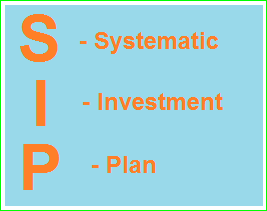Almost everyone of us has some goal or ambition in our life which we plan to achieve,for some it can be buying a house or a car at some point of time in future,for others it can be children's education or marriage or their own retirement planning or financial independence.All these goals require huge sums of money to be take care of.
 Now,everyone has goals but unfortunately very few of us are aware of the tools available to achieve these goals.To accomplish these goals requires very careful planning and discipline
Now,everyone has goals but unfortunately very few of us are aware of the tools available to achieve these goals.To accomplish these goals requires very careful planning and disciplineon the part of the person.Systematic Investment Plan or SIP as popularly it is called is one such tool which can be very beneficial to achieve your goal of wealth creation.
What is SIP?
Systematic Investment Plan (SIP) is the method of investment in stock market through Mutual Fund or Stock Investing route in predefined installments on regular fixed intervals over a defined time period.
Investment intervals can be taken anything from daily,weekly,fortnightly,monthly or quarterly as per individual requirements.Similarly,installment of the amount to be invested can be selected as per comfort of the investor.Usually,there is some lowest amount fixed by each company which the investor can opt to invest and there are multiples of that installment which can be chosen for investment.
Let us take an example.Suppose a person X wishes to invest Rs.4000 per month in a mutual fund for the next 5 years.He shall choose a good quality mutual fund for SIP investment.He can have the option to invest the amount either Rs 4000 monthly or Rs 1000 weekly or Rs 2000 fortnightly for the next 5 years.
How SIPs work?
SIPs are considered best investment tool for those people who have not much knowledge of stock markets or who can not actively track the markets but yet want the exposure of the market to grow their investment.
Mutual funds remain the very good option to start a SIP for these people.Here,professional fund managers hired by the mutual fund companies do the work of managing the portfolios,the investor just needs to invest in the fund.
Each mutual fund scheme has a NAV or Net Asset Value which moves with the markets just like the price moves in the stocks but the movement in the fund is not as dynamic as in the stocks.When you opt for a SIP, you buy the mutual funds at the NAV price available on the date of buying and Units are allotted to your portfolio. When the markets are moving higher ,the NAV of the fund rises and you get less Units and when the markets are moving lower the NAV falls which results in more number of Units allotted. In this way,your buying gets averaged over the time period.
SIPs has the potential to yield 12% plus returns in the longer investment horizons though being a market dependent instrument, the returns depend how the markets behave over that period of time.
The early you start,the better it is:
An individual should start investing as early as possible to yield best results from the SIP.The younger you start,the better are the probability of reaching towards your goal of wealth creation.
The real power of SIP lies in the Time horizon you devote for investing.The compounding factor also comes into play when the period of investment is longer.Let's explain with an example:-
Suppose there are two persons,Bobin and Stephan which are employed and want to retire at 55 years of age.Currently,Bobin is 25 years and Stephan is 35 years old.Both want to have a corpus of Rs.1 crore ( 10 million ) at their retirement to enjoy their post retirement period.
They start investing via SIP route in a mutual fund which is expected to provide a return of 12% over that time horizon.Now Bobin have 30 years and Stephan have 20 years to accomplish the goal.To reach the goal of Rs 1 crore,Stephan needs to invest Rs 10,109 per month for the next 20 years while Stephan needs only Rs 2861 to be invested every month for the next 30 years.
In this process,if we calculate the amounts invested by them up to their retirement,we find that Stephan ends up investing Rs 24,26,160 while Bobin had to invest only Rs.10,29,960 to reach the same goal of Rs 1 crore.So starting late investment for his retirement costs Stephan almost 2.5 times than that of Bobin.
How to plan for a Goal?
Before starting a SIP,define your Goal.This is very important.Only after have decoded your Goal,you can choose the amount you need to invest and time period required for that investment.
There are several types of SIP Calculators available which help you to calculate the monthly investment required to reach the Goal or the target amount you can accumulate by investing an amount fixed by you for a particular period of time.
After you have planned everything,then you have follow it in disciplined manner.Keep investing every month or week whatever interval you have chosen.
Advantages of SIP Investment:
-No need to time the market.By SIP,you continue to invest irrespective of the market levels.You buy more when markets are falling and buy less when markets are rising ,giving you the benefit of Rupee cost averaging over the longer period.
-Makes you disciplined towards your investment and goal achievement.
-Risk of market movements is minimized by rupee cost averaging.
-You need not to invest in lump sums.Small regular investments do the trick.
-Helps in accumulation of wealth over the longer time horizons by compounding factor.
You may also like Equity Systematic Investment Plan ( ESIP ) or Systematic Equity Plan ( SEP )
You may also like Equity Systematic Investment Plan ( ESIP ) or Systematic Equity Plan ( SEP )




No comments:
Post a Comment